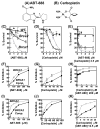Enhancement of synthetic lethality via combinations of ABT-888, a PARP inhibitor, and carboplatin in vitro and in vivo using BRCA1 and BRCA2 isogenic models
- PMID: 22778154
- PMCID: PMC3551628
- DOI: 10.1158/1535-7163.MCT-11-0597
Enhancement of synthetic lethality via combinations of ABT-888, a PARP inhibitor, and carboplatin in vitro and in vivo using BRCA1 and BRCA2 isogenic models
Abstract
Individuals with an inherited BRCA1 or BRCA2 mutation have an elevated risk of developing breast cancer. The resulting tumors typically lack homologous recombination repair as do a subset of sporadic tumors with acquired BRCA deficiency. Clinical responses to monotherapy with platinum drugs or poly PARP inhibitors (PARPi) have been shown for BRCA-associated cancers. However, there are limited data on combination therapy with PARPi and platinum drugs, the mechanism of action of this combination, and the role of BRCA1 or BRCA2 in chemosensitivity. We compared the efficacy of ABT-888 (a PARPi) with that of cisplatin or carboplatin (platinum drugs) alone or in combinations by examining the survival of treated Brca-proficient and -deficient mouse embryonic stem cells. In addition, drug-induced growth inhibition of a BRCA1 and a BRCA2 null cell line were compared with their isogenic BRCA-complemented lines. Although each monotherapy killed or inhibited proliferation of Brca/BRCA-deficient cells, an enhanced effect was observed after treatment with ABT-888 in combination with carboplatin. Moreover, the ABT-888/carboplatin combination delayed tumor growth in Brca2 xenografts. The drugs caused DNA damage and apoptosis. Along with greater PARP activity in Brca/BRCA-deficient cells, these effects correlated with increased chemosensitivity. Our data suggest that ABT-888 and carboplatin combination treatment will be more successful than monotherapy in addressing many BRCA-associated cancers. A randomized phase II trial has recently been initiated to test this hypothesis to assist in the discovery of more effective therapies for patients with BRCA.
©2012 AACR.
Conflict of interest statement
No potential conflicts of interest
Figures





Similar articles
-
The PARP1 selective inhibitor saruparib (AZD5305) elicits potent and durable antitumor activity in patient-derived BRCA1/2-associated cancer models.Genome Med. 2024 Aug 26;16(1):107. doi: 10.1186/s13073-024-01370-z. Genome Med. 2024. PMID: 39187844 Free PMC article.
-
BRCA Status Does Not Predict Synergism of a Carboplatin and Olaparib Combination in High-Grade Serous Ovarian Cancer Cell Lines.Mol Pharm. 2018 Jul 2;15(7):2742-2753. doi: 10.1021/acs.molpharmaceut.8b00246. Epub 2018 Jun 1. Mol Pharm. 2018. PMID: 29750868
-
A phase I followed by a randomized phase II trial of two cycles carboplatin-olaparib followed by olaparib monotherapy versus capecitabine in BRCA1- or BRCA2-mutated HER2-negative advanced breast cancer as first line treatment (REVIVAL): study protocol for a randomized controlled trial.Trials. 2016 Jun 21;17(1):293. doi: 10.1186/s13063-016-1423-0. Trials. 2016. PMID: 27323902 Free PMC article. Clinical Trial.
-
PARP inhibitors in breast cancer: Bringing synthetic lethality to the bedside.Cancer. 2018 Jun 15;124(12):2498-2506. doi: 10.1002/cncr.31307. Epub 2018 Apr 16. Cancer. 2018. PMID: 29660759 Free PMC article. Review.
-
Resurrection of PARP Inhibitors in Breast Cancer.J Natl Compr Canc Netw. 2018 Sep;16(9):1150-1156. doi: 10.6004/jnccn.2018.7031. J Natl Compr Canc Netw. 2018. PMID: 30181424 Review.
Cited by
-
BRCA1 and TP53 codeficiency causes a PARP inhibitor-sensitive erythroproliferative neoplasm.JCI Insight. 2022 Dec 22;7(24):e158257. doi: 10.1172/jci.insight.158257. JCI Insight. 2022. PMID: 36346676 Free PMC article.
-
The role of DNA damage and repair in decitabine-mediated apoptosis in multiple myeloma.Oncotarget. 2014 May 30;5(10):3115-29. doi: 10.18632/oncotarget.1821. Oncotarget. 2014. PMID: 24833108 Free PMC article.
-
HP1β is a biomarker for breast cancer prognosis and PARP inhibitor therapy.PLoS One. 2015 Mar 13;10(3):e0121207. doi: 10.1371/journal.pone.0121207. eCollection 2015. PLoS One. 2015. PMID: 25769025 Free PMC article.
-
p66ShcA potentiates the cytotoxic response of triple-negative breast cancers to PARP inhibitors.JCI Insight. 2021 Feb 22;6(4):e138382. doi: 10.1172/jci.insight.138382. JCI Insight. 2021. PMID: 33470989 Free PMC article.
-
Synergistic interaction between cisplatin and PARP inhibitors in non-small cell lung cancer.Cell Cycle. 2013 Mar 15;12(6):877-83. doi: 10.4161/cc.24034. Epub 2013 Feb 21. Cell Cycle. 2013. PMID: 23428903 Free PMC article.
References
-
- Venkitaraman AR. Linking the cellular functions of BRCA genes to cancer pathogenesis and treatment. Annu Rev Pathol. 2009;4:461–87. - PubMed
-
- Bryant HE, Schultz N, Thomas HD, Parker KM, Flower D, Lopez E, et al. Specific killing of BRCA2-deficient tumours with inhibitors of poly(ADP-ribose) polymerase. Nature. 2005;434:913–7. - PubMed
-
- Farmer H, McCabe N, Lord CJ, Tutt AN, Johnson DA, Richardson TB, et al. Targeting the DNA repair defect in BRCA mutant cells as a therapeutic strategy. Nature. 2005;434:917–21. - PubMed
Publication types
MeSH terms
Substances
Grants and funding
LinkOut - more resources
Full Text Sources
Other Literature Sources
Medical
Miscellaneous

